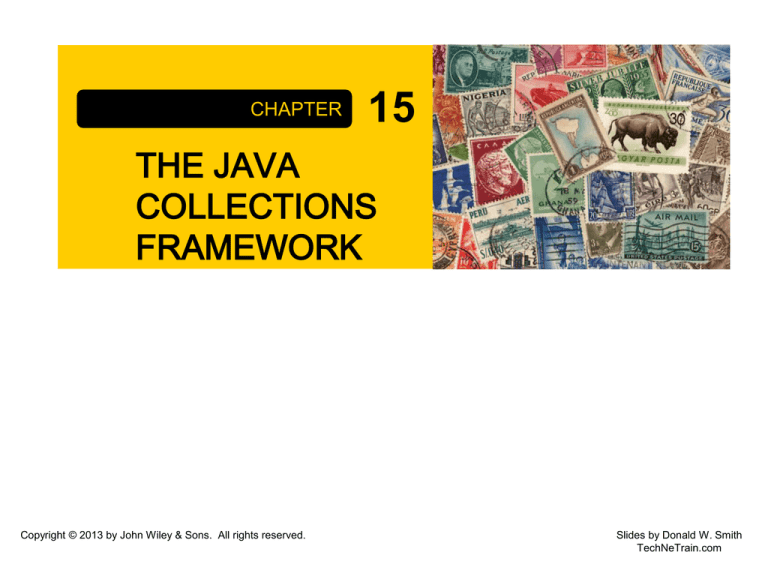
CHAPTER
15
THE JAVA
COLLECTIONS
FRAMEWORK
Copyright © 2013 by John Wiley & Sons. All rights reserved.
Slides by Donald W. Smith
TechNeTrain.com
Chapter Goals
To learn how to use the collection classes
supplied in the Java library
To use iterators to traverse collections
To choose appropriate collections for
solving programming problems
To study applications of stacks and queues
Copyright © 2013 by John Wiley & Sons. All rights reserved.
Page 2
Contents
An Overview of the Java Collections
Framework
Linked Lists
Sets
Maps
Stacks Queues and Priority Queues
Stack and Queue Applications
In this chapter, you will learn about
the Java collection framework, a
hierarchy of interface types and
classes for collecting objects
Copyright © 2013 by John Wiley & Sons. All rights reserved.
Page 3
15.1 Java Collections Framework
When you need to organize multiple objects in
your program, you can place them into a collection
The ArrayList class that was introduced in
Chapter 6 is one of many collection classes that
the standard Java library supplies
Each interface type is implemented by one or
more classes
A collection groups together
elements and allows them to be
accessed and retrieved later
Copyright © 2013 by John Wiley & Sons. All rights reserved.
Page 4
Collections Framework Diagram
Each collection class implements an interface
from a hierarchy
Each class is designed for a
specific type of storage
Copyright © 2013 by John Wiley & Sons. All rights reserved.
Page 5
Lists and Sets
Ordered Lists
ArrayList
• Stores a list of items in a dynamically sized array
LinkedList
• Allows speedy insertion and removal of items from
the list
A list is a collection that maintains
the order of its elements.
Copyright © 2013 by John Wiley & Sons. All rights reserved.
Page 6
Lists and Sets
Unordered Sets
HashSet
• Uses hash tables to speed up finding, adding, and
removing elements
TreeSet
• Uses a binary tree to speed up finding, adding, and
removing elements
A set is an unordered collection
of unique elements.
Copyright © 2013 by John Wiley & Sons. All rights reserved.
Page 7
Stacks and Queues
Another way of gaining efficiency in a
collection is to reduce the number of
operations available
Two examples are:
Stack
• Remembers the order of its elements, but it does
not allow you to insert elements in every position
• You can only add and remove elements at the top
Queue
• Add items to one end (the tail)
• Remove them from the other end (the head)
• Example: A line of people waiting for a bank teller
Copyright © 2013 by John Wiley & Sons. All rights reserved.
Page 8
Maps
A map stores keys, values, and the associations
between them
Example:
Barcode keys and books
A map keeps associations
between key and value objects.
Keys
Provides an easy way to represent an object (such as a
numeric bar code)
Values
The actual object that is associated with the key
Copyright © 2013 by John Wiley & Sons. All rights reserved.
Page 9
The Collection Interface (1)
List, Queue and Set are specialized interfaces
that inherit from the Collection interface
All share the following commonly used methods
Copyright © 2013 by John Wiley & Sons. All rights reserved.
Page 10
The Collection Interface (2)
Copyright © 2013 by John Wiley & Sons. All rights reserved.
Page 11
15.2 Linked Lists
Linked lists use references to maintain an ordered
lists of ‘nodes’
The ‘head’ of the list references the first node
Each node has a value and a reference to the next
node
They can be used to implement
• A List Interface
• A Queue Interface
Copyright © 2013 by John Wiley & Sons. All rights reserved.
Page 12
Linked Lists Operations
Efficient Operations
Insertion of a node
• Find the elements it goes between
• Remap the references
Removal of a node
• Find the element to remove
• Remap neighbor’s references
Visiting all elements in order
Inefficient Operations
Random access
Copyright © 2013 by John Wiley & Sons. All rights reserved.
Each instance variable is declared just
like other variables we have used.
Page 13
LinkedList: Important Methods
Copyright © 2013 by John Wiley & Sons. All rights reserved.
Page 14
Generic Linked Lists
The Collection Framework uses Generics
Each list is declared with a type field in < > angle brackets
LinkedList<String> employeeNames = . . .;
LinkedList<String>
LinkedList<Employee>
Copyright © 2013 by John Wiley & Sons. All rights reserved.
Page 15
List Iterators
When traversing a LinkedList, use a ListIterator
Keeps track of where you are in the list.
LinkedList<String> employeeNames = . . .;
ListIterator<String> iter = employeeNames.listIterator()
Use an iterator to:
Access elements inside a linked list
Visit other than the first and the last nodes
Copyright © 2013 by John Wiley & Sons. All rights reserved.
Page 16
Using Iterators
Think of an iterator as pointing between two
elements
ListIterator<String> iter = myList.listIterator()
iterator.next();
iterator.add(“J”);
Note that the generic type for the listIterator
must match the generic type of the LinkedList
Copyright © 2013 by John Wiley & Sons. All rights reserved.
Page 17
Iterator and ListIterator Methods
Iterators allow you to move through a list easily
Similar to an index variable for an array
Copyright © 2013 by John Wiley & Sons. All rights reserved.
Page 18
Iterators and Loops
Iterators are often used in while and “for-each” loops
hasNext returns true if there is a next element
next returns a reference to the value of the next element
while (iterator.hasNext())
{
String name = iterator.next();
// Do something with name
}
for (String name : employeeNames)
{
// Do something with name
}
Where is the iterator in the “for-next” loop?
• It is used ‘behind the scenes’
Copyright © 2013 by John Wiley & Sons. All rights reserved.
Page 19
Adding and Removing with Iterators
Adding
iterator.add("Juliet");
A new node is added AFTER the Iterator
The Iterator is moved past the new node
Removing
Removes the object that was returned with the last call to
next or previous
It can be called only once after next or previous
You cannot call it immediately after a call to add.
If you call the remove
method improperly, it throws
an IllegalStateException.
Copyright © 2013 by John Wiley & Sons. All rights reserved.
while (iterator.hasNext())
{
String name = iterator.next();
if (condition is true for name)
{
iterator.remove();
}
}
Page 20
ListDemo.java (1)
Illustrates adding, removing and printing a list
Copyright © 2013 by John Wiley & Sons. All rights reserved.
Page 21
ListDemo.java (2)
Copyright © 2013 by John Wiley & Sons. All rights reserved.
Page 22
15.3 Sets
A set is an unordered collection
It does not support duplicate elements
The collection does not keep track of the order in
which elements have been added
Therefore, it can carry out its operations more efficiently
than an ordered collection
The HashSet and TreeSet classes both
implement the Set interface.
Copyright © 2013 by John Wiley & Sons. All rights reserved.
Page 23
Sets
HashSet: Stores data in a Hash Table
TreeSet: Stores data in a Binary Tree
Both implementations arrange the set
elements so that finding, adding, and
removing elements is efficient
Set implementations arrange the elements
so that they can locate them quickly
Copyright © 2013 by John Wiley & Sons. All rights reserved.
Page 24
Hash Table Concept
Set elements are grouped into smaller collections
of elements that share the same characteristic
It is usually based on the result of a mathematical
calculation on the contents that results in an integer
value
In order to be stored in a hash table, elements must
have a method to compute their integer values
100
101
102
Copyright © 2013 by John Wiley & Sons. All rights reserved.
Page 25
hashCode
The method is called hashCode
• If multiple elements have the same hash code, they
are stored in a Linked list
The elements must also have an equals
method for checking whether an element
equals another like:
• String, Integer, Point, Rectangle, Color, and all
collection classes
Set<String> names = new HashSet<String>();
Copyright © 2013 by John Wiley & Sons. All rights reserved.
Page 26
Tree Concept
Set elements are kept in sorted order
Nodes are not arranged in a linear sequence
but in a tree shape
In order to use a TreeSet, it must be possible to
compare the elements and determine which one
is “larger”
Copyright © 2013 by John Wiley & Sons. All rights reserved.
Page 27
TreeSet
Use TreeSet for classes that implement
the Comparable interface
•String and Integer, for example
• The nodes are arranged in a ‘tree’ fashion
so that each ‘parent’ node has up to two
child nodes.
– The node to the left always has a ‘smaller’ value
– The node to the right always has a ‘larger’ value
Set<String> names = new TreeSet<String>();
Copyright © 2013 by John Wiley & Sons. All rights reserved.
Page 28
Iterators and Sets
Iterators are also used when processing sets
hasNext returns true if there is a next element
next returns a reference to the value of the next element
add via the iterator is not supported for TreeSet and HashSet
Iterator<String> iter = names.iterator();
while (iter.hasNext())
{
for (String name : names)
String name = iter.next();
{
// Do something with name
// Do something with name
}
}
• Note that the elements are not visited in the order in which you
inserted them.
• They are visited in the order in which the set keeps them:
– Seemingly random order for a HashSet
– Sorted order for a TreeSet
Copyright © 2013 by John Wiley & Sons. All rights reserved.
Page 29
Working With Sets (1)
Copyright © 2013 by John Wiley & Sons. All rights reserved.
Page 30
Working With Sets (2)
Copyright © 2013 by John Wiley & Sons. All rights reserved.
Page 31
SpellCheck.java (1)
Copyright © 2013 by John Wiley & Sons. All rights reserved.
Page 32
SpellCheck.java (2)
Copyright © 2013 by John Wiley & Sons. All rights reserved.
Page 33
Programming Tip 15.1
Use Interface References to Manipulate Data
Structures
It is considered good style to store a reference to a
HashSet or TreeSet in a variable of type Set.
Set<String> words = new HashSet<String>();
• This way, you have to change only one line if you decide to use
a TreeSet instead.
Copyright © 2013 by John Wiley & Sons. All rights reserved.
Page 34
Programming Tip 15.1 (continued)
Unfortunately the same is not true of the ArrayList,
LinkedList and List classes
• The get and set methods for random access are
very inefficient
Also, if a method can operate on arbitrary collections,
use the Collection interface type for the parameter:
public static void removeLongWords(Collection<String> words)
Copyright © 2013 by John Wiley & Sons. All rights reserved.
Page 35
15.4 Maps
A map allows you to associate elements from a key
set with elements from a value collection.
The HashMap and TreeMap classes both
implement the Map interface.
Use a map to look up objects by using a key.
Copyright © 2013 by John Wiley & Sons. All rights reserved.
Page 36
Maps
Key
Value
Key
Value
Map<String, Color> favoriteColors = new HashMap<String, Color>();
Copyright © 2013 by John Wiley & Sons. All rights reserved.
Page 37
Working with Maps (Table 5)
Copyright © 2013 by John Wiley & Sons. All rights reserved.
Page 38
Key Value Pairs in Maps
Each key is associated with a value
Map<String, Color> favoriteColors = new HashMap<String, Color>();
favoriteColors.put("Juliet", Color.RED);
favoriteColors.put(“Romeo", Color.GREEN);
Color julietsFavoriteColor = favoriteColors.get("Juliet");
favoriteColors.remove("Juliet");
Copyright © 2013 by John Wiley & Sons. All rights reserved.
Page 39
Iterating through Maps
To iterate through the map, use a keySet to get the list
of keys:
Set<String> keySet = m.keySet();
for (String key : keySet)
{
Color value = m.get(key);
System.out.println(key + "->" + value);
}
To find all values in a map,
iterate through the key set
and find the values that
correspond to the keys.
Copyright © 2013 by John Wiley & Sons. All rights reserved.
Page 40
MapDemo.java
Copyright © 2013 by John Wiley & Sons. All rights reserved.
Page 41
Steps to Choosing a Collection
1) Determine how you access values
Values are accessed by an integer position. Use an
ArrayList
• Go to Step 2, then stop
Values are accessed by a key that is not a part of the
object
• Use a Map.
It doesn’t matter. Values are always accessed “in
bulk”, by traversing the collection and doing something
with each value
2) Determine the element types or key/value types
For a List or Set, a single type
For a Map, the key type and the value type
Copyright © 2013 by John Wiley & Sons. All rights reserved.
Page 42
Steps to Choosing a Collection
3) Determine whether element or key order matters
Elements or keys must be sorted
• Use a TreeSet or TreeMap. Go to Step 6
Elements must be in the same order in which they were
inserted
• Your choice is now narrowed down to a LinkedList or an
ArrayList
It doesn’t matter
• If you chose a map in Step 1, use a HashMap and go to Step 5
Copyright © 2013 by John Wiley & Sons. All rights reserved.
Page 43
Steps to Choosing a Collection
4) For a collection, determine which operations
must be fast
Finding elements must be fast
• Use a HashSet and go to Step 5
Adding and removing elements at the beginning or the
middle must be fast
• Use a LinkedList
You only insert at the end, or you collect so few
elements that you aren’t concerned about speed
• Use an ArrayList.
Copyright © 2013 by John Wiley & Sons. All rights reserved.
Page 44
Steps to Choosing a Collection
5) For hash sets and maps, decide if you need to
implement the equals and hashCode methods
If your elements do not support them, you must
implement them yourself.
6) If you use a tree, decide whether to supply a
comparator
If your element class does not provide it, implement the
Comparable interface for your element class
Copyright © 2013 by John Wiley & Sons. All rights reserved.
Page 45
Special Topic: Hash Functions
Hashing can be used to find elements in a set
data structure quickly, without making a linear
search through all elements.
A hashCode method computes and returns an
integer value: the hash code.
Should be likely to yield different hash codes
Because hashing is so important, the Object class has
a hashCode method that computes the hash code of
any object x.
int h = x.hashCode();
Copyright © 2013 by John Wiley & Sons. All rights reserved.
Page 46
Computing Hash Codes
To put objects of a given class into a HashSet or use
the objects as keys in a HashMap, the class should
override the default hashCode method.
A good hashCode method should work such that
different objects are likely to have different hash codes.
It should also be efficient
A simple example for a String might be:
int h = 0;
for (int i = 0; i < s.length(); i++)
{
h = h + s.charAt(i);
}
Copyright © 2013 by John Wiley & Sons. All rights reserved.
Page 47
Computing Hash Codes
But Strings that are permutations of another (such as
"eat" and "tea") would all have the same hash code
Better:
• From the Java Library!
final int HASH_MULTIPLIER = 31;
int h = 0;
for (int i = 0; i < s.length(); i++)
{
h = HASH_MULTIPLIER * h + s.charAt(i);
}
Copyright © 2013 by John Wiley & Sons. All rights reserved.
Page 48
Sample Strings and HashCodes
The String class implements a good example of a
hashCode method
It is possible for two or more distinct objects to have the
same hash code: This is called a collision
A hashCode function should minimizes collisions
Copyright © 2013 by John Wiley & Sons. All rights reserved.
Page 49
Computing Object Hash Codes
You should have a good hashCode method for your
own objects to store them efficiently
Override hashCode methods in your own classes by
combining the hash codes for the instance variables
public int hashCode()
{
int h1 = name.hashCode();
int h2 = new Double(area).hashCode();
. . .
Then combine the hash codes using a prime-number
hash multiplier:
final int HASH_MULTIPLIER = 29;
int h = HASH_MULTIPLIER * h1 + h2;
return h;
}
Copyright © 2013 by John Wiley & Sons. All rights reserved.
Page 50
hashCode and equals methods
hashCode methods should be compatible with
equals methods
If two objects are equal, their hashCodes should match
a hashCode method should use all instance variables
The hashCode method of the Object class uses the
memory location of the object, not the contents
Copyright © 2013 by John Wiley & Sons. All rights reserved.
Page 51
hashCode and equals methods
Do not mix Object class hashCode or equals methods
with your own:
• Use an existing class such as String. Its hashCode and equals
methods have already been implemented to work correctly.
• Implement both hashCode and equals.
– Derive the hash code from the instance variables that the equals method
compares, so that equal objects have the same hash code
• Implement neither hashCode nor equals. Then only identical
objects are considered to be equal
Copyright © 2013 by John Wiley & Sons. All rights reserved.
Page 52
15.5 Stacks, Queues and Priority Queues
Queues and Stacks are specialized lists
Only allow adding and removing from the ends
Insert At
Remove At
Operation
Stack
Start(top)
Start(top)
List in, first out (LIFO)
Queue
End (tail)
Start (head)
First in, first out (FIFO)
Priority Queue
By Priority
Highest
Priority
(Lowest #)
Prioritized list of tasks
Copyright © 2013 by John Wiley & Sons. All rights reserved.
Page 53
Stacks, Queues and Priority Queues
Stacks are used for undo features
(most recent first)
Queues are like lines at the bank
or store
Priority Queues remove lowest
number first
Copyright © 2013 by John Wiley & Sons. All rights reserved.
Page 54
Working with Stacks
Copyright © 2013 by John Wiley & Sons. All rights reserved.
Page 55
Stack Example
The Java library provides a Stack class that
implements the abstract stack type’s push and
pop operations.
The Stack is not technically part of the Collections
framework, but uses generic type parameters
The stack class
provides a size method
Stack<String> s = new Stack<String>();
s.push("A");
s.push("B");
s.push("C");
// The following loop prints C, B, and A
while (s.size() > 0)
{
System.out.println(s.pop());
}
Copyright © 2013 by John Wiley & Sons. All rights reserved.
Page 56
Queues and Priority Queues
Copyright © 2013 by John Wiley & Sons. All rights reserved.
Page 57
Priority Queues
A priority Queue collects elements, each of which
has a priority
Example: a collection of work requests, some of which
may be more urgent than others
It is NOT a FIFO Queue
PriorityQueue<WorkOrder> q = new PriorityQueue<WorkOrder>();
q.add(new WorkOrder(3, "Shampoo carpets"));
q.add(new WorkOrder(1, "Fix broken sink"));
q.add(new WorkOrder(2, "Order cleaning supplies"));
Lowest value priority (1) will be removed first
WorkOrder next = q.remove();
Copyright © 2013 by John Wiley & Sons. All rights reserved.
// removes “Fix broken sink”
Page 58
15.6 Stack and Queue Applications
Balancing Parenthesis
Section 2.5, showed how to balance parenthesis by
adding 1 for each left ( and subtracting for each right )
A stack can be used to keep track of ‘depth’:
When you see an opening parenthesis, push it on the stack.
When you see a closing parenthesis, pop the stack.
If the opening and closing parentheses don’t match
The parentheses are unbalanced. Exit.
If at the end the stack is empty
The parentheses are balanced.
Else
The parentheses are not balanced.
Copyright © 2013 by John Wiley & Sons. All rights reserved.
Page 59
Using a Stack (Example)
Here is a walkthrough of the sample expression
We will use the mathematical version (three types of parenthesis)
Copyright © 2013 by John Wiley & Sons. All rights reserved.
Page 60
Reverse Polish Expressions
The first handheld calculator used a notation that was easily
implemented with a stack: Reverse Polish
No parenthesis required if you…
• Input both operands first, then the operator:
Algebra
Reverse Polish
(3 + 4) x 5
3 4 + 5 x
(3 + 4) x (5 + 6)
3 4 + 5 6 + x
Copyright © 2013 by John Wiley & Sons. All rights reserved.
Page 61
Reverse Polish Expressions
If you read a number
Push it on the stack.
Else if you read an operand
Pop two values off the stack.
Combine the values with the operand.
Push the result back onto the stack.
Else if there is no more input
Pop and display the result.
Copyright © 2013 by John Wiley & Sons. All rights reserved.
Page 62
Reverse Polish Calculator
Walkthrough with 3 4 5 + x
Copyright © 2013 by John Wiley & Sons. All rights reserved.
Page 63
Calculator.java (1)
Copyright © 2013 by John Wiley & Sons. All rights reserved.
Page 64
Calculator.java (2)
Copyright © 2013 by John Wiley & Sons. All rights reserved.
Page 65
Evaluating Algebraic Expressions
Can be done with two stacks:
1) Numbers
2) Operators
First Example: 3 + 4
Copyright © 2013 by John Wiley & Sons. All rights reserved.
Page 66
Expression Example 2
Second Example: 3 x 4 + 5
Must use precedence (multiply before adding)
Copyright © 2013 by John Wiley & Sons. All rights reserved.
Page 67
Precedence and Expressions (1)
Third Example: 3 + 4 x 5
Keep operators on the stack until they are ready to be
evaluated
Copyright © 2013 by John Wiley & Sons. All rights reserved.
Page 68
Precedence and Expressions (2)
Third Example: 3 + 4 x 5
Evaluate top 2 numbers with top operator
Store result on top of stack
Evaluate until operator stack is empty
Copyright © 2013 by John Wiley & Sons. All rights reserved.
Page 69
Expressions with Parenthesis (1)
Fourth Example: 3 x ( 4 + 5 )
If (, don’t evaluate. If ), evaluate
Copyright © 2013 by John Wiley & Sons. All rights reserved.
Page 70
Expressions with Parenthesis (2)
Fourth Example: 3 x ( 4 + 5 )
Don’t put ) on stack – evaluate now
Ignore (
Copyright © 2013 by John Wiley & Sons. All rights reserved.
Page 71
Precedence Algorithm
If you read a number
Push it on the number stack.
Else if you read a (
Push it on the operator stack.
Else if you read an operator op
While the top of the stack has a higher precedence than op
Evaluate the top.
Evaluate the Top:
Push op on the operator stack.
Pop two numbers off the
Else if you read a )
number stack.
While the top of the stack is not a (
Pop an operator off the
Evaluate the top.
operator stack.
Pop the ).
Combine the numbers with
Else if there is no more input
that operator.
While the operator stack is not empty
Push the result on the
Evaluate the top.
number stack.
Copyright © 2013 by John Wiley & Sons. All rights reserved.
Page 72
Backtracking (1)
Uses a stack to solve a maze
Stack current location, arrow
for each possible path
1. We pop off the topmost one,
traveling north from (3, 4).
Following this path leads to
position (1, 4).
2. We now push two choices
on the stack, going west or
east.
Copyright © 2013 by John Wiley & Sons. All rights reserved.
Page 73
Backtracking (2)
3. Pop off (1, 4) east. It is a
dead end.
4. Pop off (1, 4) west. It is a
dead end.
5. Now we pop off the path
from (3, 4) going east. That
too is a dead end.
This leaves us with (3, 4) south
and (3, 4) west to try
Copyright © 2013 by John Wiley & Sons. All rights reserved.
Page 74
Backtracking (3)
6. Next is the path from (3, 4)
going south. At (5, 4), it comes
to an intersection. Both choices
are pushed on the stack.
7. (5, 4) south is a dead end.
8. (5, 4) west is a dead end.
9. Finally, the path from (3, 4)
going west leads to an exit
Copyright © 2013 by John Wiley & Sons. All rights reserved.
Page 75
Maze Solving Pseudocode
Push all paths from the point on which you are standing on
a stack.
While the stack is not empty
Pop a path from the stack.
Follow the path until you reach an exit, intersection,
or dead end.
If you found an exit
Congratulations!
Else if you found an intersection
Push all paths meeting at the intersection, except
the current one, onto the stack.
Copyright © 2013 by John Wiley & Sons. All rights reserved.
Page 76
Summary: Collections
A collection groups together elements
and allows them to be retrieved later
A list is a collection that remembers the
order of its elements
A set is an unordered collection of unique
elements
A map keeps associations between key
and value objects
Copyright © 2013 by John Wiley & Sons. All rights reserved.
Page 77
Summary: Linked Lists
A linked list consists of a number of nodes, each
of which has a reference to the next node
Adding and removing elements in the middle of a linked
list is efficient
Visiting the elements of a linked list in sequential order
is efficient, but random access is not
You use a list iterator to access elements of a linked list
Copyright © 2013 by John Wiley & Sons. All rights reserved.
Page 78
Summary: Choosing a Set
The HashSet and TreeSet classes both implement the Set
interface.
Set implementations arrange the elements so that they can
locate them quickly.
You can form hash sets holding objects of type String,
Integer, Double, Point, Rectangle, or Color.
You can form tree sets for any class that implements the
Comparable interface, such as String or Integer.
Sets don’t have duplicates. Adding a duplicate of an
element that is already present is silently ignored.
A set iterator visits the elements in the order in which the
set implementation keeps them.
You cannot add an element to a set at an iterator position.
Copyright © 2013 by John Wiley & Sons. All rights reserved.
Page 79
Summary: Maps
Maps associate keys with values
The HashMap and TreeMap classes both implement the
Map interface
To find all keys and values in a Map, iterate through the
key set and find the values that correspond to the keys
A hash function computes an integer value from an
object.
A good hash function minimizes collisions—identical
hash codes for different objects.
Override hashCode methods in your own classes by
combining the hash codes for the instance variables.
A class’s hashCode method must be compatible with its
equals method.
Copyright © 2013 by John Wiley & Sons. All rights reserved.
Page 80
Summary: Stacks and Queues
A stack is a collection of elements with
“last-in, first-out” retrieval.
A queue is a collection of elements with
“first-in, first-out” retrieval.
When removing an element from a priority
queue, the element with the most urgent
priority is retrieved.
Copyright © 2013 by John Wiley & Sons. All rights reserved.
Page 81
Summary: Problem Solving
A stack can be used to check whether parentheses in
an expression are balanced.
Use a stack to evaluate expressions in reverse Polish
notation.
Using two stacks, you can evaluate expressions in
standard algebraic notation.
Use a stack to remember choices you haven’t yet
made so that you can backtrack to them.
Copyright © 2013 by John Wiley & Sons. All rights reserved.
Page 82









